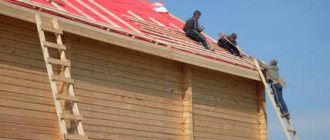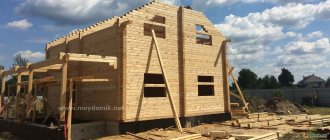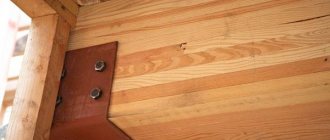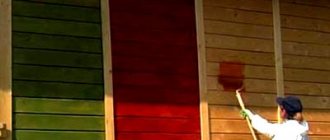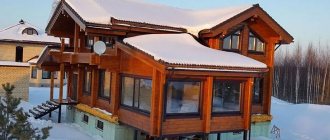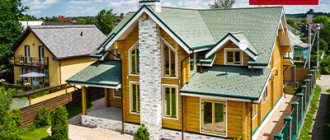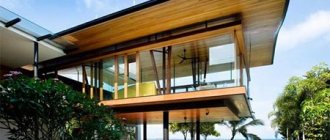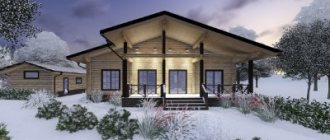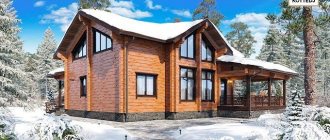The choice of material is the primary problem faced by anyone who decides to build a small, reliable and comfortable house on their own site. The modern building materials market can boast a huge range of raw materials to suit every taste and budget. Most people prefer wood. And it’s not surprising, because wooden beams are an environmentally friendly and inexpensive material.
This material is presented in several variations, but in this article we will talk about how to build a house with your own hands from profiled timber, since it is the most common and has the simplest installation technology. It is very malleable for processing, which means that you can install electrical wiring, plumbing and sewerage without much difficulty.
Drawing up a plan, preparing materials and tools
Without a good project, it is simply unrealistic to build a house, so it is very important to take this stage extremely seriously, especially since it is at this stage that you can clearly understand where you can save.
Ideally, you can turn to special design agencies for help. For a fee, they will individually draw up a complete layout of your future home, taking into account the size and shape of your territory, soil composition, financial capabilities and, most importantly, personal preferences.
If you do not need any miracle of design thought, then you can build a building using standard options. To do this, all the necessary documentation can be found on free Internet resources or you can use one of several 3D editor programs, including FloorPlan3D, CyberMotion 3D-Designer, SEMA and many others. The latter, by the way, is designed specifically for the layout of houses made of timber. SEMA will help you carry out all the necessary statistical calculations, select the type of rafter system and much more.
The drawing should indicate everything, from the general dimensions of the building and the number of floors to the location of door and window openings, furniture, and all communications (light, water, heat).
As soon as the plan is in your hands, you can begin to calculate, if this has not already been done, and select the required materials and tools, including:
- Timber as the main building material.
You can buy ready-made beams with the necessary cut grooves and tenons - bring them, install them - use them, also thanks to the perfectly flat and smooth surface of the edges there is no need for additional finishing work, or you can buy wooden blanks and make the notches yourself, there is nothing complicated about it, and you can save a lot of money.
Profiled timber retains heat indoors better than its analogues
Experts recommend using timber with a cross-section of 150x150 mm during construction. But since you have to work alone or with an unqualified assistant, it is better to use material with a cross-section of 150x100 mm. Such timber is much lighter, and the missing volume can be restored in the future by insulating the facade from the outside of the building.
- Insulation.
To save additional money, you can use materials that are, so to speak, “at hand” as insulation. Moss is considered the best among these. It is not difficult to find and process, and its technical characteristics are identical to its artificial counterparts.
- Nails, screws and other fastening structures (metal corners, wooden dowels, etc.).
- Waterproofing material (for example, roofing felt).
- Ready-made concrete solution or the components necessary for its preparation (water, sand, crushed stone, cement).
- Reinforcement (if a strip foundation is planned).
- Saw.
- Jigsaw.
- Screwdriver.
- Hammer.
- Construction rubber hammer.
- Roulette.
- Building level.
- Plumb.
- Circular Saw.
- Pipes for water supply and sewerage.
- Cable for electricity, TV.
- Master OK.
- Caulk.
- Other tools for small and decorative work.
Flaws
It would be unfair to omit this section. However, it will be much shorter.
- The first thing you have to think about at the design stage is the price. Glued laminated timber is somewhat more expensive than profiled timber.
- The second is the need for periodic processing of wooden structures, especially from the outside, in order to extend their service life.
Let's finish here. The remaining shortcomings are not so significant and can be easily solved as they arise to focus attention on them.
Harvesting wood and moss for construction
To build a warm and cozy house from timber, in addition to knowing the technology of laying crowns, it is important to understand which type of wood is best suited for this purpose.
Each species, naturally, has its own advantages and disadvantages, but the main thing you need to pay attention to when choosing lumber is strength, density, moisture resistance and degree of drying. So, if the wood is fragile, then your house may very soon simply fall apart; if the density is low, then such material can shrink by up to 20, or even more percent. If a lot of moisture accumulates in the wood fibers, then such a house will never be warm, but if the raw materials are under-dried, then it will simply be impossible to work with them; if the raw materials are over-dried, the material will become too unreliable.
Very serious requirements are placed on the walls of the house, as they must provide warmth, comfort and low noise levels in the premises, especially since wood is a rather fire-hazardous material that can be deformed due to weather precipitation. That is why experts recommend purchasing timber from coniferous species such as spruce, cedar, fir, larch and some others. Due to the high content of resinous substances, conifers are resistant to rotting, cracking and other deformations. Also, trees of this species are very durable, light, and therefore do not create too much load on the foundation.
By choosing softwood timber, you can save money by building a foundation using a simplified system.
If you decide to harvest the wood yourself, then you should know that the humidity coefficient should not exceed 20%, otherwise cracks will soon begin to appear in the walls, which will require additional processing, and this will waste effort, time and budget.
When harvesting, take into account the fact that it is better to do this in the winter period of the year (from January to March), since in winter the process of photosynthesis slows down and the speed of movement of juices along the tree trunk becomes minimal.
Cut the lumber to the desired shape and size, treat it with an antiseptic and leave it stored in a dry place out of reach of sunlight. The bars must be stored compactly in special stacks, at a height of at least half a meter from the ground. There should be a gap of 4-5 and 10-15 cm between the crowns and rows. To do this, several transverse beams are inserted between them. After lying like this for 5-6 months, the tree is ready for further processing and installation.
To keep your home warm in inclement weather, you should think about choosing inter-crown insulation. Professional builders use modern strip materials, but the price for such pleasure is quite high, so we recommend paying attention to moss.
There are more than 300 species of this plant in the world, but only a few varieties are used for construction purposes, among them: sphagnum, cuckoo moss, red moss and peat moss. All of them have excellent bactericidal properties and are excellent natural antiseptics. Among the disadvantages is a high flammability, since after drying the moss becomes dry and brittle, for example, at high temperatures it can spontaneously ignite, to prevent this it is treated with special means.
Moss must be collected; it can be found in swampy areas - these are long, up to 30 cm, stems with small leaves, dried and stored in a dry place for about two weeks. You can use plastic bags as bags, but then the moss will be a little damp. There's nothing wrong with that.
Types of timber
Timber is made from wood by cutting logs. Its cross-section is rectangular or square. The size ranges from 10×10 cm or 40×40 cm. The material can be used for building houses on a light foundation. A favorable atmosphere is created inside such a structure. For construction, profiled, planed or glued materials are used.
Planed
House made of planed timber
Planed timber is the simplest type of building material, to obtain which 4 sides of the edge of the log are cut off. No complex processing equipment is required. Additionally, the surface of the elements is polished. The timber has no mechanical damage and does not require additional processing.
The driest raw materials are used for production. This material has the following qualities:
- availability;
- low price;
- environmental cleanliness.
Such a log house is not easy to lay, since there are no longitudinal profiled grooves. The timber has natural moisture, so after the construction is completed, it needs time to shrink. Over time, cracks may appear in the material as it dries out. Construction is accompanied by additional costs for finishing and thermal insulation of the house. Untreated timber is susceptible to fungus.
Profiled
A house made of profiled timber does not need to be caulked with jute - the logs fit tightly to each other.
This type of timber is made from a single log. After additional processing, the product has a complex cross-section profile. The surfaces of the elements do not require additional finishing. There are locking joints on the beam, ensuring the tightest possible fit. The house turns out durable and warm.
Profiled timber has the following qualities:
- no need to caulk the walls: jute is placed only in corner and end connections;
- decorativeness;
- reliability of connections;
- high quality material;
- environmental cleanliness.
Profiled timber with natural moisture is subject to shrinkage, during which cracks may appear on it.
Glued and double
Glued laminated timber is the most durable material with a low degree of shrinkage.
Glued laminated timber is considered one of the best materials for building a house. It is a product assembled from individual elements glued together under great pressure. Each of them is laid in the opposite direction of the fibers, so the material is very durable. The lamellas are solid or spliced.
Since the percentage of humidity in such timber is low, it is practically not susceptible to rotting. Complex projects are built from it. In addition, the material is not subject to shrinkage, so further finishing can be done immediately, although it is rarely required. Glued laminated timber is expensive.
Double timber is a whole structure made of laminated veneer lumber. The connection of the elements is a sealed lock that is not blown through. There is a heat insulator between the outer and inner elements. The distance between them is 13-15 cm. This design is heat- and energy-efficient, environmentally friendly. The shrinkage of the house when using double timber does not exceed 2%.
Foundation construction
A high-quality foundation is the key to a reliable, stable and durable home. Since it is the main supporting structure that must support the total weight of the building, such high demands are placed on it.
When building a house from timber, three main types of foundations are used:
- Pile-screw.
- Gnezdovoy.
- Tape.
The choice of foundation type depends mainly on the soil on which the house is planned to be built. This issue must be resolved at the planning stage. You should conduct a soil analysis, you can also ask your neighbors what foundation their houses are on, or look for information in documents about the purchase of a plot or other reference literature.
If the soil is heaving or watery, and also if you plan to use the house only seasonally, and not live there permanently, then use one of the first two options. If it contains a large amount of sand or clay, then a strip foundation is suitable.
The first thing to start with is clearing the area of debris, thickets, bushes and other objects that may interfere. Immediately before digging it is necessary to mark. To do this, they use ordinary wooden pegs, which are placed in the corners of the site, as well as along the load-bearing walls, and a thread that is pulled between them - everything is simple. Subsequent actions depend on the selected type of foundation.
Pile-screw foundation
After the area is cleared and ready for further manipulation, we proceed to excavation work. It is better to pre-purchase metal piles from a specialized store, since it is quite difficult to build such structures by hand. Choose supports of the same size and always have drills already welded at one end.
Construction of a pile-screw foundation
Thanks to the special design, the piles are easy to install yourself, while keeping an eye on the angle of inclination. A building magnetic level can help you with this. Also, if there was no cap on the screws, you will need to install it yourself. To do this, use a processed sheet of metal 25x25 cm and 5-6 mm thick.
Nest foundation
The nested foundation differs only in that instead of metal piles, either monolithic concrete supports or hollow pipes with a diameter of 250-300 mm are used, into which cement mortar is poured after installation.
As soon as the territory has been marked, it is necessary to dig holes at selected points along the perimeter with a depth of 2/3 of the height of the support. A layer of sand is poured onto the bottom, moistened and compacted tightly. After this, support structures are inserted into them at right angles, and if necessary, a solution is poured inside and into the space around them at the bottom. The remaining gaps between the supports and the ground are filled with a mixture of sand and crushed stone.
There is also an option to install formwork in the dug holes and fill it with concrete mortar to ground level; we recommend using M400 cement in a ratio of 1:3 to sand. After the cement has completely dried, the formwork is removed and aerated concrete or foam blocks 20x20x40 cm are laid on top.
Strip foundation
The strip foundation is the most common, as it can be used in the vast majority of cases, for example, if you are planning to build a heavy two- or more-story house.
The first step is to dig a trench 10-15 centimeters wider than the thickness of the walls and 50-70 cm deep. It should be located at a height of at least a meter from the groundwater level.
There are several options for strip foundations, including:
- Brick.
- Concrete.
- Stone.
For any of them it is necessary to prepare a foundation. A layer (10 cm) of sand is placed at the bottom of the trench, moistened with a small amount of water and compacted thoroughly; if necessary, sand can be poured in two layers. A layer (15-20 cm) of crushed stone, broken brick or small stones is poured on top of it.
By the way, geotextiles can be pre-laid at the bottom of the trench, and thermal insulation material can be installed along the outer edge - this will help prevent freezing of the shallow foundation.
If you plan to build a brick or stone base, a little before reaching the top of the foundation, you can install formwork on the resulting cushion. It is necessary to pour a layer of mortar inside to the level of the ground surface and compact it. To increase stability, we recommend creating a reinforcing frame from metal rods with a diameter of 1.2-1.5 mm.
Already on top, after the solution has completely hardened, bricks or stones are laid, which can be ordered, or used independently found near any body of water. Another reinforcement belt is installed on top of the masonry and concreted (height 5-10 cm) and leveled.
If a concrete base is planned, then the height of the formwork should reach 30-50 cm, thickness 2-3 cm. If the formwork is planned to be made of wood, then the material should be free of cracks, chips, unevenness and other defects.
The reinforcement is installed in increments of 10-20 cm. The distance between the rows is 5-10 cm. The result should be a grid with cells of 15-20 sq. cm. The rods are tied together with rigid wire, the whole structure is filled with cement mortar, which can either be purchased or prepare in person. We recommend investing in a concrete mixer - this will save you time and nerves, since mixing cement by hand is quite long and difficult. The formwork must first be moistened with water or wrapped in a layer of plastic film.
It is very important to prevent the appearance of bubbles before the solution hardens. A vibrating hammer will help with this, or you can simply punch holes in several places; later they will need to be filled with mortar.
The foundation is left to dry for 3-4 weeks. The formwork can be removed after 5-7 days, during which and several more days, the solution must be sprayed with water in order to prevent cracking of the foundation. Don't forget to make holes for communication wiring.
Construction and insulation of walls and floors
The crowns of the first row are connected to each other traditionally, regardless of the method of connecting subsequent rows, “half-tree” is a fairly reliable and easy-to-make type of end notches, and they are not laid directly on the foundation, but on a lining of small slats located transversely to the beam itself , at a distance of 5-10 cm from each other. The gaps between the slats can be filled with foam. To cut the end notch, you can use a hacksaw, and use a chisel to remove excess material.
So, if the slats rot, they will be easier to replace than a whole row of timber. The planks also need to be treated with an antiseptic or primer to prevent the development of fungus and various microorganisms, and laid on a foundation covered in two layers of waterproofing material, such as roofing felt.
The timber of the first row should have slightly larger dimensions than the crowns of the remaining rows, for example, if a material with a cross-section of 150x150 mm is used for the walls, then for the first row use the option with a cross-section of 200x200 mm.
It will be possible to mount logs for the subfloor on the lining of the planks using steel angles and nails or screws. It is necessary to attach the so-called cranial beam to them, on which the edged board for the subfloor will be laid in the future. A layer of waterproofing should be laid on top of the draft, and on top of it insulation boards, such as mineral wool, polystyrene foam or any other modern analogue. The next layer is a vapor barrier, and then the finished floor.
Scheme of arrangement and insulation of a timber floor
All subsequent rows are laid identically to each other. There are two main ways to fasten bars:
- “With a remainder” is when a small part of the beam protrudes from its two ends.
- "Without a trace."
The picture below shows different types of end notches.
This manipulation can be done using a circular saw or jigsaw. Options “A” and “D” (“without remainder”) are the most reliable for residential buildings, but also the most difficult to install. Recommended for areas where annual precipitation does not exceed 300 mm. Option “Z” is used to connect internal load-bearing walls. Also note that tongue-and-groove connections must leave a gap of half a centimeter for the insulation.
The rows are fastened together using wooden or metal dowels. We recommend using the latter, since during drying the lumber will not crack, which will ensure the durability of your building.
Using dowels for fastening, it is necessary to drill holes with a diameter of 30-40 mm. It is necessary to drill so that the beam of one row of dowels goes through, and the beam of the bottom row only partially, or you can use short dowels; for this, holes are cut out on two opposite sides, a dowel is driven into one with a hammer, and simply inserted into the next. Remember that the dowels should not be located on top of each other. To make the structure as stable as possible, arrange them in a checkerboard pattern, as shown in the figure below.
If the walls of your house turn out to be longer than the timber, it’s not a problem. In this case, you need to cut a rectangular hole at the end of one beam, and at the end of the second a rectangular protrusion right in the center, so you get a tongue-and-groove joint.
The space between the crowns can be insulated using pre-collected and dried moss and tow. The tow is laid across the beams, and the moss is simply thrown on top. Thus, when installing the upper crown, part of the insulation will stick out - this is not a problem, since caulking work is planned in the future, and this, in turn, will provide maximum thermal insulation.
To ensure that the bars of one row are at the same height, we use a rubber hammer, tapping it along the walls after installing each beam. The plane is used at the end, only after you have noticed that due to the unevenness of the bottom row it is impossible to install the timber of the top row.
*Important! Don't forget to alternate corner joints.
The last two rows of crowns are not fastened, since in the future, after shrinkage, the rafter system will be installed. To do this, you will have to temporarily dismantle these two rows.
To design door and window openings, you can use two methods: either lay out all the rows, and then, after making a mark, cut out the necessary holes with a jigsaw, or use beams of such length in advance that they will subsequently form windows and doors. Remember that the size of the openings must exceed the size of the door or window itself, since it is still necessary to leave space for installing window and door frames. It is also necessary to leave a gap of 10-15 cm above the windows and doors. This is necessary so that in the future, when the timber shrinks, it does not damage the structure of the windows or doors. It will need to be filled with liquid insulation.
DIY assembly is easy
Timber is a modern and convenient material. For those who have used it in construction, it is quite obvious that:
- Assembly is quick. It can be produced in 1 month, even without special skills.
- Using a ready-made house kit greatly simplifies the work.
Connecting laminated veneer lumber into a finished house is easy if you follow all the steps exactly, but it will lead to disastrous results if you are lax about it.
Roof roof
After the last row of crowns has been erected, the building must be covered with roofing felt or slate and allowed to settle. The shrinkage period takes up to 6 months on average, only after which you can proceed to installing the roof and facing work.
There are a huge number of variations of roofs. A hip or hip roof is considered the most reliable and stable; it is used in regions with high humidity and strong winds, but since it is quite difficult to build it without the help of specialists, we recommend installing a gable roof. We will briefly describe the installation steps and the main elements.
First, you need to insulate the surface of the walls from moisture, using, for example, roofing felt. It must be laid in two layers. After that, the Mauerlat is attached - the base for the rafter system, in which special cutouts are made, with the help of which the rafter legs are attached. The top row of crowns, pre-treated with an antiseptic, will serve as the Mauerlat.
The rafters themselves, depending on the area of the house, should be made of timber with a section of 100x50, 150x50 or 200x50 mm. They should not protrude beyond the house by more than half a meter; if more, additional supports will be installed. A wooden sheathing of slats 5-6 cm thick and 10-20 cm wide is installed on the rafter legs in increments that depend on the roofing material (tiles - planks are laid end to end, if slate or corrugated sheeting - at a distance of 30 cm from each other). Sometimes a counter-lattice is installed, on top of which the roofing material itself is mounted. Insulation, vapor and waterproofing are laid in the resulting space between the two sheathings.
The ceiling consists of several ceiling joists, which are attached using the tongue-and-groove method to the top row of timber. The remaining manipulations are identical to the floor. You can additionally lay insulation and insulation between the finished and rough ceilings. In the future, this can reduce heat loss by up to 30%.
In order for the roof to be stable, strong, withstand strong winds and last for many years, it is worth thinking about additional supporting structures, such as crossbars, struts, tie rods, racks and others. All of them are attached using hardware, such as steel angles and self-tapping screws.
Do not forget to leave ventilation gaps, an opening for the chimney and the attic, if one is planned. The roof fronts can be covered with clapboard or decorative block house.
Remember! Any roof will require repairs over time. Therefore, in order to reduce financial costs, experts recommend checking the coating annually for damage and various deformations, such as deflection and leakage. The first is eliminated by installing additional supports (crossbars, racks, etc.), and the leak is eliminated by replacing rotten roofing material.
Finishing
Putting a roof on a house is a big victory when building on your own. Now you don't have to worry about the durability of your log house.
Finishing work should begin from the facade. If planed timber was used, then only it needs to be painted with protective decorative compounds. When working with edged timber, they are treated with an antiseptic and the façade is sheathed with finishing materials. For cladding, imitation timber, blockhouse, siding (vinyl or metal), facade panels, fiber cement siding or panels can be used. Working with sheathing materials is always the same: installing sheathing from timber or profiles and fastening the sheathing material using self-tapping screws or special fasteners - a clamp.
A special place in the finishing is occupied by the installation of windows and doors. Shrinkage of the log house in height requires the installation of additional shrinkage boxes. The simplest is the installation of rough T-shaped casing boxes. At the ends of the timber in the sawn openings, a groove measuring 50x50 mm or 50x40 mm is selected using a router. A beam is placed in it, along which the settling timber of the walls will slide. A dry board with a thickness of at least 40 mm and a width equal to the thickness of the wall is attached to this beam. A board of a similar cross-section is placed at the top and bottom. A gap of 2 to 10 cm is left above the top board of the box, depending on the material used (dry or natural moisture). You can safely install windows and doors in these boxes in accordance with their standard technology for brick houses.
We can talk a lot and for a long time about the interior decoration of a house and communications. The variety of finishing materials and engineering systems can lead even an experienced builder into the wilds. Try to study the issue specifically for your finishing option. The Internet and expert advice on forums will provide you with real help with this.
Let's summarize
The last stage of construction work is the installation of entrance and interior doors and windows. If necessary, work is carried out on insulation and decorative finishing of walls either inside or outside the house. They provide electricity, water, heat, and connect the sewerage system.
A house made of timber with your own hands is fast, simple, beautiful and inexpensive
Now that you know the main stages of building a house from timber on your own, as well as ways to save money, you can begin building a warm, cozy and reliable home that will warm and delight you for many years.
How to properly install windows in a timber wall
If the opening in the wall was made in a rough version (see above), then the installation of the window begins with cutting out the opening to the desired size. To do this, a lath is filled along the edge of the cut, item 2 in the figure, and the beams are sawed off along the edge of the lath with a chain saw.
Correct installation of a window in a wall made of timber.
1 - wall; 2 - rail; 3 - casing; 4 - window; 5 - window frame; 6 - wall beam above the window; 7 — inter-crown insulation; 8 - shrinkage gap above the window and deck; 9 - window frames; 10 - wall beam (pier); 11 - deck; 12 - nail.
Then, using a circular saw, tenons are cut out at the ends of the wall beams (wall). The deck, pos. 11, is placed on the tenons, pos. 10, with a groove. The joints are sealed with insulation. The deck is nailed to the wall beam with nails driven in at an angle, pos. 12. This way the nails will not interfere with the shrinkage of the frame.
A window frame is inserted into the opening prepared in this way, which is attached to the deck with self-tapping screws. above the window frame , item 8, to compensate for shrinkage of the frame . The gap size is 5-7 cm. The gap is filled with soft insulating material.
An expansion gap must also be left above the upper end of the deck.
Openings are prepared in the same way and doors are inserted into the walls made of timber.
After completing the assembly of the first floor of the house, the log house is covered with beams of interfloor or attic (if the building is one-story) floor.
Wooden attic beams can be a structural element of the roof truss system. And they can also perform an independent function.
The next page describes the structure of a broken roof of a house made of timber, where the floor beams simultaneously serve as an element of the load-bearing frame of the attic roof.
Watch the video clip, which describes and shows in some detail the technology for installing a log house from construction timber.
More articles on this topic:
⇒ A proper residential house made of timber ⇒ A broken roof of a house made of timber with an attic ⇒ Insulation of the façade of a house made of timber with mineral wool
More articles on this topic
- Sheathing, wall cladding with basement siding
- Floors on the ground on the first floor of a private house without a basement
- Setting up gas boiler power adjustment
- Economy class house
- How to properly make a floor screed in a private house
- Steel ball valves
- House, wall made of thermal block, thermal wall, flint granite, polyblock
- How to install a plastic window in a house correctly according to GOST
